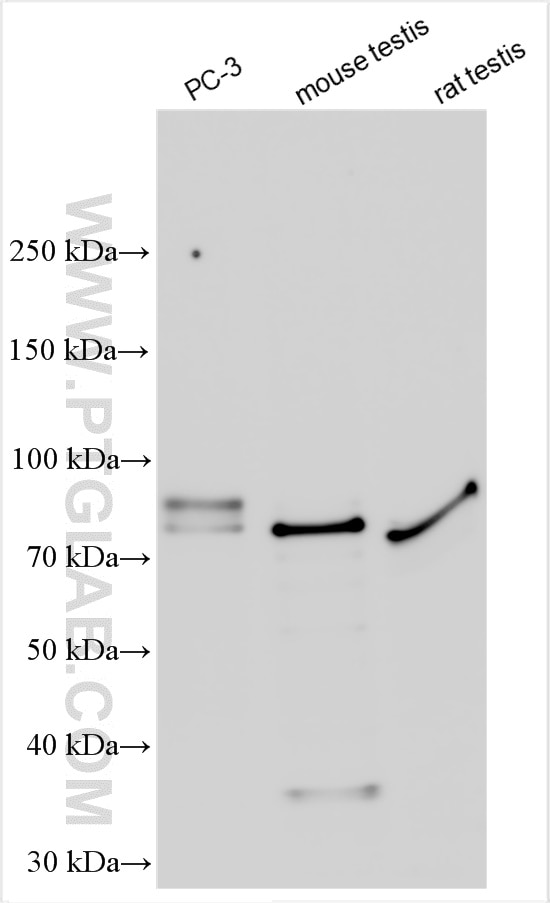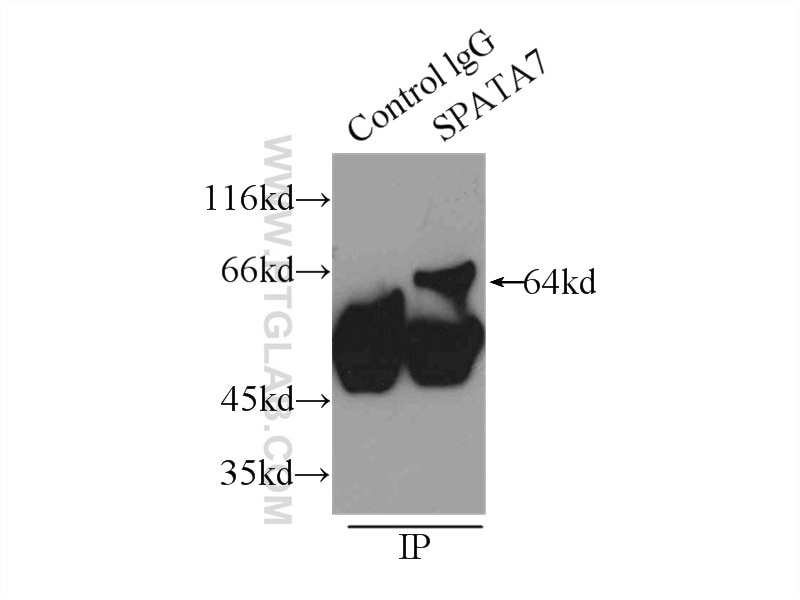Validation Data Gallery
Tested Applications
| Positive WB detected in | PC-3 cells, mouse testis tissue, rat testis tissue |
| Positive IP detected in | mouse testis tissue |
Recommended dilution
| Application | Dilution |
|---|---|
| Western Blot (WB) | WB : 1:500-1:1000 |
| Immunoprecipitation (IP) | IP : 0.5-4.0 ug for 1.0-3.0 mg of total protein lysate |
| It is recommended that this reagent should be titrated in each testing system to obtain optimal results. | |
| Sample-dependent, Check data in validation data gallery. | |
Published Applications
| KD/KO | See 2 publications below |
| WB | See 3 publications below |
| IHC | See 1 publications below |
| IF | See 2 publications below |
Product Information
12020-1-AP targets SPATA7 in WB, IP, IF, IHC, ELISA applications and shows reactivity with human, mouse, rat samples.
| Tested Reactivity | human, mouse, rat |
| Cited Reactivity | mouse |
| Host / Isotype | Rabbit / IgG |
| Class | Polyclonal |
| Type | Antibody |
| Immunogen |
CatNo: Ag2649 Product name: Recombinant human SPATA7 protein Source: e coli.-derived, PGEX-4T Tag: GST Domain: 120-468 aa of BC008656 Sequence: SFLSQYRYYTPAKRKKDFTDQRIEAETQTELSFKSELGTAETKNMTDSEMNIKQASNCVTYDAKEKIAPLPLEGHDSTWDEIKDDALQHSSPRAMCQYSLKPPSTRKIYSDEEELLYLSFIEDVTDEILKLGLFSNRFLERLFERHIKQNKHLEEEKMRHLLHVLKVDLGCTSEENSVKQNDVDMLNVFDFEKAGNSEPNELKNESEVTIQQERQQYQKALDMLLSAPKDENEIFPSPTEFFMPIYKSKHSEGVIIQQVNDETNLETSTLDENHPSISDSLTDRETSVNVIEGDSDPEKVEISNGLCGLNTSPSQSVQFSSVKGDNNHDMELSTLKIMEMSIEDCPLDV 相同性解析による交差性が予測される生物種 |
| Full Name | spermatogenesis associated 7 |
| Calculated molecular weight | 599 aa, 68 kDa |
| Observed molecular weight | 68-80 kDa |
| GenBank accession number | BC008656 |
| Gene Symbol | SPATA7 |
| Gene ID (NCBI) | 55812 |
| RRID | AB_2195380 |
| Conjugate | Unconjugated |
| Form | |
| Form | Liquid |
| Purification Method | Antigen affinity purification |
| UNIPROT ID | Q9P0W8 |
| Storage Buffer | PBS with 0.02% sodium azide and 50% glycerol{{ptg:BufferTemp}}7.3 |
| Storage Conditions | Store at -20°C. Stable for one year after shipment. Aliquoting is unnecessary for -20oC storage. |
Background Information
SPATA7, also named as HSD3, may be involved in retinal function. It is interesting to note that mutations in SPATA7 cause LCA and RP/ARRP , two overlapping but distinct human retinal diseases. SPATA7 is another LCA and Juvenile RP Gene.(PMID:19268277) It is a highly conserved, vertebrate-specific protein which expressed in the mature retina. For some modification, the MW always migrate 5-8kd. The antibody can reoginze all the 3 isoforms of SPATA7.
Protocols
| Product Specific Protocols | |
|---|---|
| IP protocol for SPATA7 antibody 12020-1-AP | Download protocol |
| WB protocol for SPATA7 antibody 12020-1-AP | Download protocol |
| Standard Protocols | |
|---|---|
| Click here to view our Standard Protocols |
Publications
| Species | Application | Title |
|---|---|---|
Am J Hum Genet Mutations in SPATA7 cause Leber congenital amaurosis and juvenile retinitis pigmentosa. | ||
Hum Mol Genet Spata7 is a retinal ciliopathy gene critical for correct RPGRIP1 localization and protein trafficking in the retina.
| ||
Gene Ther AAV8(Y733F)-mediated gene therapy in a Spata7 knockout mouse model of Leber congenital amaurosis and retinitis pigmentosa.
| ||
Exp Eye Res Conditional loss of Spata7 in photoreceptors causes progressive retinal degeneration in mice. |


